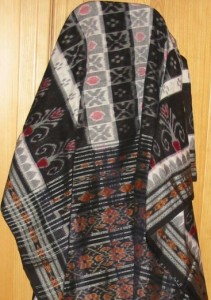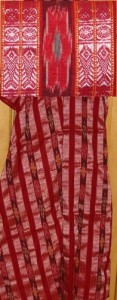(Mir ist gerade aufgefallen, daß ich im letzten Beitrag einen Teil vergessen habe zu übersetzen, deswegen geht es diesmal auf englisch los…)
In my last post I forgot something in the English version, so this post starts in English…
 Most thrilling saree question is: how to wrap it? Well, I never tried (somehow we never had time for that and my friends petticoats wouldn’t fit me), but the internet is full of nice descriptions:
Most thrilling saree question is: how to wrap it? Well, I never tried (somehow we never had time for that and my friends petticoats wouldn’t fit me), but the internet is full of nice descriptions:
Most important rule: Do as you like!
The basic principle is clear: wrap around your body, make some pleats in the front, go on wrapping and throw the rest, the pallu, over you (left) shoulder so it can hang decoratively over your back. Sarbari says, her mother can do without pins, but from observation I got the imoression that many indian women secure the pallu on the blouse, either with a sefaty bin oder a decorative brooch.
Of course I looked how women would were there saris in every day life… the result is: as they choose. Some wear it low on their hips, exposing a lot of bare skin, others manage to wrap it very high, nearly on the chest, so that the saree couvers them completely.
The Pallu can hang freely on the back, but it also can be brought forward under the other arm and tucked in there. Sometimes just an edge, sometimes the whole largeness of the cloth. Or you prefer to throw the Pallu from the back over the shoulder that it can hang in front? Or tuck it in there. Or you tuck your Pallu in the petticoat at the back. Some drape the Pallu over their head or let it form a small cowl at the back and therefore having a small part of the Pallu hanging in the front,…
This Wikipedia article explains also local variation. We mainly travelled in the south of India and I saw a lot of variation there.
 Die nächsten Saris mußten wegen der absolut faszimierenden Herstellungstechnik mit. Nur zwei davon mitzunehmen fiel mir wirklich schwer…
Die nächsten Saris mußten wegen der absolut faszimierenden Herstellungstechnik mit. Nur zwei davon mitzunehmen fiel mir wirklich schwer…
Sagt euch der Begriff Ikat etwas?
Bei Ikat (die es nicht nur in Indien gibt) liegt das Muster im Garn.
Das Garn wird vor dem Weben gefärbt. Dabei werden die Garnstränge abgebunden und nacheinander in den verschiedenen Farben gefärbt.
Ist dieser komplizierte Prozess vollendet, muß das Garn nur noch gewebt werden und schon entsteht das Muster.
Da ich das einfach faszinierend finde, landeten hier zwei neue, handgewebte Baumwollsaris in meinem Koffer.
Und da sie dann auch noch Meterware hatten, Ikatstreifen abwechselnd mit Brokatweberei… landeten von diesem Baumwoll-Seide Gemisch auch noch ein paar Meter bei mir.
Rot… kann ich immer so ganz schlecht widerstehen.
(Und das könnte jetzt endlich der Stoff sein, der zu meinem Rest roten Wollstoffes paßt, der zu viel ist, um ihn wegzuwerfen, aber zu wenig, um alleine etwas sinnvolles zu ergeben….)
(Der Nachteil von Baumwollsaris, so habe ich mir sagen lassen, liegt darin, daß sie gestärkt werden müssen. Schon wieder so ein unerwartet komplizierter Schritt…)
 For these sarees I have no real idea what they might become, but the technique is so fascinating, that I hat to buy at least two of them. (And it was hard to narrow down my choice on two…)
For these sarees I have no real idea what they might become, but the technique is so fascinating, that I hat to buy at least two of them. (And it was hard to narrow down my choice on two…)
Do you know Ikat?
Ikat (the technique is empoyed in other countries, too) means, the pattern is in the thread.
The thread gets dyed before weaving in a tie-dye technique. with tieing for every colour separately, of course. And once this process is finished, you just weave it and the wonderfull motives do form themselves on the loom.
I’ve always loved that technique, so I couldn’t resist those handloom products. Isn’t it amazing, how a simple thread forms complicated patterns?
And the red one… this isn’t even a sari, this is fabric by the meter. Alternate stripes in ikat and brocade weave, cotton and silk, and in… red! No way to resist…
(And this might finally be the fabric that goes with my red woolen fabric that I have her since… well… quite some years and that is to much to throw away and not enough to make something useful. Hopefully this might be the coordinated fabric I have been looking for since… since log ago…)
(The drawback of cotton sarees, so I was told, is that you have to starch them after each use… still some consider them to be better in really hot and humid climate.)
